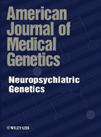 Suggestive linkage at 9p22 in bipolar disorder weighted by alcohol abuse
Suggestive linkage at 9p22 in bipolar disorder weighted by alcohol abuseAmerican Journal of Medical Genetics Part B: Neuropsychiatric Genetics Published Online: 3 Mar 2009
Bipolar disorder (BP) is a highly heritable disorder, however attempts to map genetic risk factors are challenging.
One possible reason for these difficulties is the genetic heterogeneity of BP. Hence, focusing on clinically homogeneous families to create a genetically more homogeneous sample may increase the power of finding a specific variant.
Alcohol abuse (AA) and alcohol dependence (AD) are familial in BP families, and these families may carry a specific risk variant for BP.
We tested this hypothesis by performing a genome-wide linkage scan in 638 pedigrees (1,835 individuals) from the National Institute of Mental Health Genetics Initiative for BP, weighting the evidence for linkage according to the family's frequency of AA or AD. Using AA weighting, we identified a linkage region on 9p22.2 with an NPL score of 3.23. The region had previously been identified in a meta-analysis of linkage in bipolar disorder.
We used permutation analysis to assess if weighting by AA increased the linkage signal more than expected by chance and observed a significant P-value (P = 0.048). Therefore, the genetic risk factor for BP on 9p22.2 has an increased effect in families with high levels of AA.
In summary, we present an example of using covariates such as AA and AD to define subtypes of BP, demonstrate how using such subtypes can improve the power of a linkage scan, and demonstrate statistical approaches to validate the suggested interaction
____________________________________________________
 Twelve Defining Moments in the History of Alcoholics Anonymous
Twelve Defining Moments in the History of Alcoholics Anonymous




